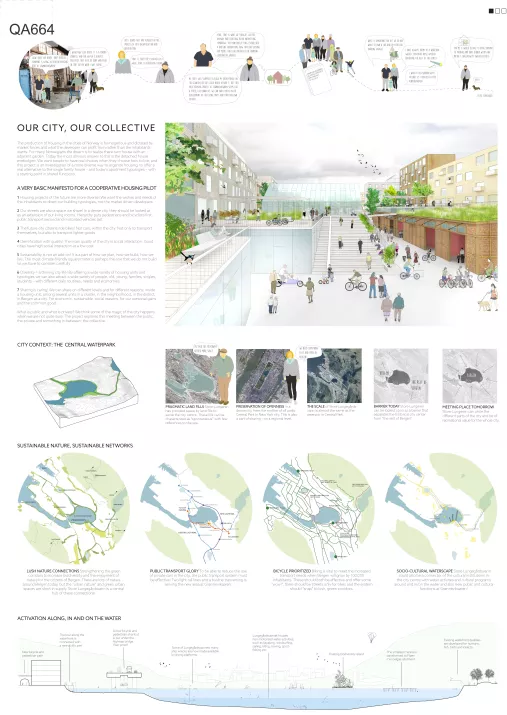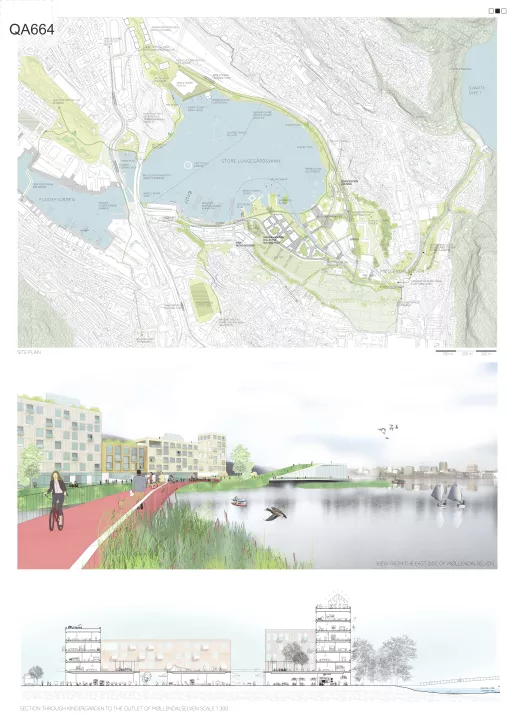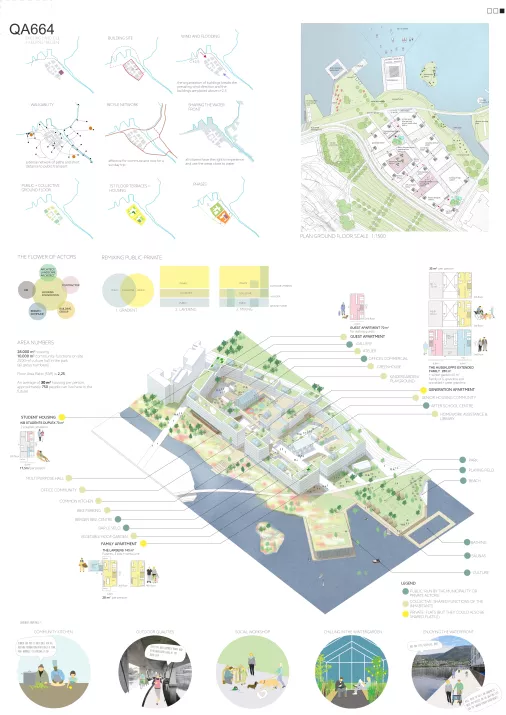Project:
Our City, Our Collective
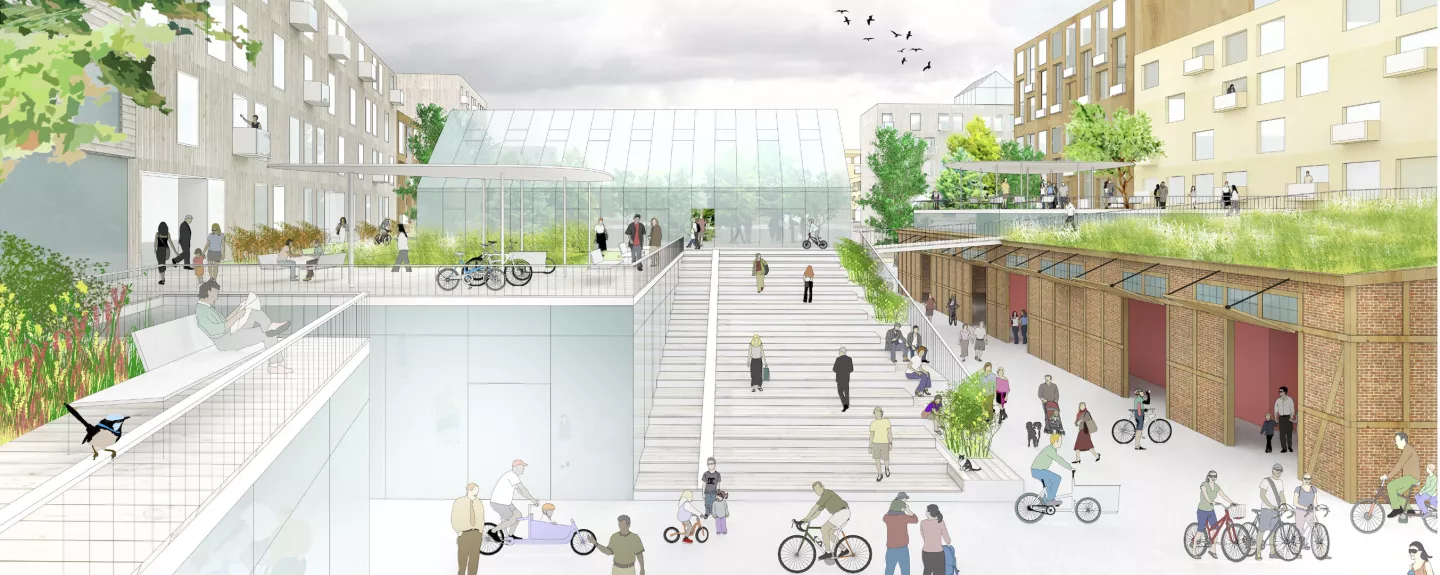
About
-
The production of housing in the cities of Norway is homogenous and dictated by market forces and what the developer can profit from rather than the inhabitants wants. For many Norwegians the dream is to realize their own house with an adjacent garden. Today the most obvious answer to this is the detached house: eneboligen. We want people to have real choices when they choose how to live, and this project is an investigation of a more diverse way to organize housing, to offer a real alternative to the single family house - and today's apartment typologies - with a starting point in shared functions.
A VERY BASIC MANIFESTO FOR A COOPERATIVE HOUSING PILOT
1- Housing projects of the future are more diverse! We want the wishes and needs of the inhabitants to direct our building typologies, not the market driven developers
2- Our streets are also a space we share! In a dense city, they should be looked at
as an extension of our living rooms. Hierarchy puts pedestrians and bicyclists first, public transport second and motorized vehicles last
3- The future city citizens ride bikes! Not cars, within the city. Not only to transport themselves, but also to transport lighter goods
4- Densification with quality! The main quality of the city is social interaction. Good cities have high social interaction at a low cost
5- Sustainability is not an add-on! It is a part of how we plan, how we build, how we live. The most climate-friendly square meter is perhaps the one that we do not build so we have to consider carefully
6- Diversity = a thriving city life! By offering a wide variety of housing units and typologies we can also attract a wide variety of people, old, young, families, singles, students - with different daily routines, needs and economies
7- Sharing is caring! We can share on different levels and for different reasons: inside a housing unit, among several units in a cluster, in the neighborhood, in the district, in Bergen as a city. For economic, sustainable, social reasons, for our personal gains and the common good.
What is public and what is private? We think some of the magic of the city happens when we are not quite sure. The project explores this meeting between the public, the private and something in-between: the collective.
-
The project Our City, Our Collective shows a clear idea and strategy on all scales. On the larger scale, the project recognizes the water promenade and the water body of Store Lungegårdsvann as a garden for the city – a central park – with an importance for Bergen as a whole. Through continuing and reinterpreting the neighbouring urban fabric of the student housing, the project proposes two hybrid city blocks consisting of a common porous ground floor that responds to urban connections in its surroundings, while the upper floors resemble two larger perimeter blocks. The proposal shows a richness in ideas and guidelines for a cooperative housing pilot and how to active the use of the waterfront.
In this project, the urban structure corresponds well to the scale of the lake and is making a clear and appropriate distinction between the public park and the project. The private and public functions on ground floor level are attractive and intriguing, providing room for a variety of shared spaces while the two larger housing perimeter blocks add a positive critical mass to Grønneviksøren as a whole. The proposal shows a variety of different apartments for all generations, not only the ”young family”, adding a series of shared facilities such as community kitchens, homework communities, after school centres, senior housing community and gardens; however, apartment sizes and layouts should be elaborated further to reflect these common facilities. The proposed city scale of the public space along the lake is workable and supports the strategic vision of envisaged socio-cultural connections. The jury sees a need for elaborating the architecture and the physical expression of the development as a whole, but are optimistic about the further realization of this proposal since the scheme seems robust enough to withhold the coming development process.
-
Team Representative: Pernille Heilmann Lien (NO) – architect; Associates: Tomas Aassved Hjorth (NO) – architect; Iwan Thomson (NO) – landscape architect
Contributor: Kari Tønseth (NO) – student in landscape architectureLala Tøyen + Kåmmån, Urtegata 32A, 0187 Oslo – Norge
+47 95 204 945– post@lala.no – www.lala.no
P. Heilmann Lien, I. Thomson, K. Tønseth & T. Aassved Hjorth
Team interview
1. How did you form the team for the competition?
The team was formed on informal discussions we had about architecture, landscape, urbanism and social topics in previous times before Europan 13. We discovered we shared a common ground in many of these topics and decided to try working together if a good opportunity came along. Europan 13 felt like the perfect occasion to form a team and work together.
2. How do you define the main issue of your project, and how did you answer on this session main topic: Adaptability through Self-Organization, Sharing and/or Project (Process)?
We felt the main issue of our project was not a single topic, but many ones intertwined, working on different scales. However, our main goal was to create a project that focused on other ways of living and building dwellings than what is the present norm in Norway. Sharing was an issue we thoroughly discussed, and the way it could help individuals gain a fuller quality of life through sharing certain social and material goods. We were also concerned with how we could implement sharing on many levels, from sharing public functions with the city of Bergen to what the inhabitants could share together in different ways. From dwellings where people would live together to more private ones where people would only share some functions or objects, like a washing machine or a lawn-mover. The sharing topic is also something we want to use as a tool to establish self-organization and adaptability. Mainly through a process where potential inhabitants can come together and influence the planning parameters, discuss shared values and hopefully create building groups and independent building-foundations where they are the creators of their own homes.
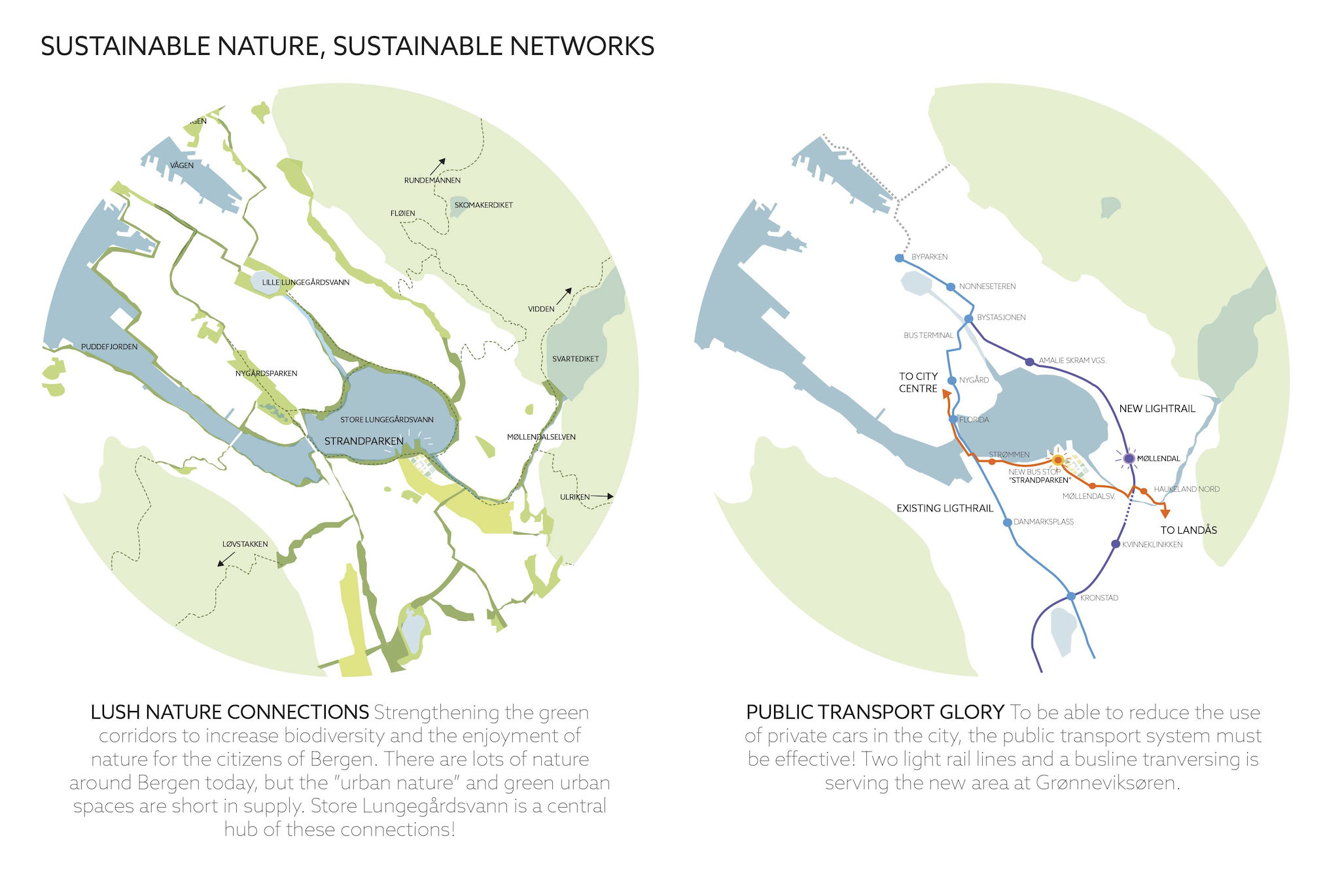
3. How did this issue and the questions raised by the site mutation meet?
The issue was of course always discussed with the site and its context within Bergen in our minds. An important case was that the sharing topic also reflected the project outwards to the public. Here the larger context was important. Making a publicly available and porous ground floor with attractive functions and a program that creates social interaction was important. The adjacent Store Lungegårdsvann Lake was treated as a large public park and the adjacent Møllendalselven River as the green vein connecting the site to the wilder nature. We are passionate about biking as a main urban transportation means and have planned the project in a way bikes are given priority over cars for everyday movement.
Further on the project is situated in a part of Bergen facing a series of rapid changes in the near future. By using the methodology of engaging potential users, the municipality and other important actors early on in the process we hope to absorb many future issues along the way and make the project less vulnerable for the ever-changing conditions of the future.
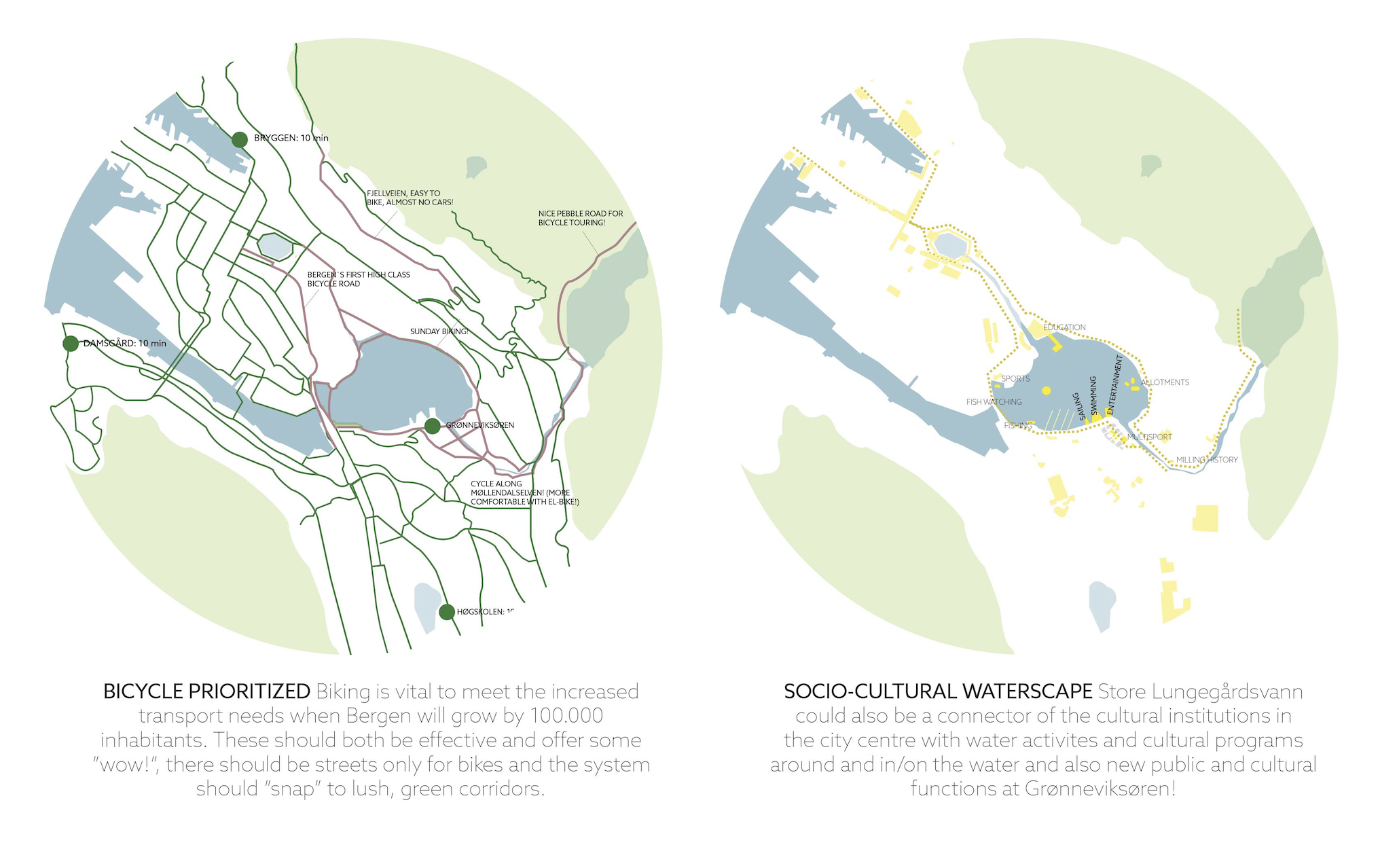
4. Have you treated this issue previously? What were the reference projects that inspired yours?
The issues we discuss in the project are themes that we take great pleasure exploring; they often work as a backdrop for other projects of both offices work with. But Grønneviksøren is maybe the first project we have approached so directly with sharing and self-organisation as a theme. We did a lot of research on the subject and talked to people with knowledge of the urban situation in Bergen in addition to already having good local knowledge of the city.
As mentioned we researched reference projects both in Norway and Europe, the ones we took extra inspiration from is the “Gaining by Sharing” model developed by Helen & Hard Architects, Kruse Smith Eiendom, Gaia Trondheim and the interviews of people living in different shared housing projects in the magazine Pollen nr. 2 by Eriksen Skajaa Architects. Outside Norway we took inspiration from different projects but especially from larger self-organised housing foundations in Europe, such as Sargfabrik in Wien (AT) and Kraftwerk1 in Zürich (CH).

5. Today –at the era of economic crisis and sustainability– the urban-architectural project should reconsider its production method in time; how did you integrate this issue in your project?
We think it is important to acknowledge that many complex issues in the world today cannot be solved through design only. In this way we like to look at this project more as an adaptable framework than a complete design. A framework for a process where many actors involved can participate and decide on the eventual output of the project. Hopefully a large part of these actors will be the end-users, the people who are going to live here. We want people to feel an ownership of the project and its surroundings from the very beginning. And as we did not plan any parking spaces for private cars in the project, that is also a very concrete sustainable solution!
To sum up we do not see ourselves as the people putting our signature on an eventual final result. But we intend to make a well-designed basis for others to work with and we want to oversee the process and make sure it is heading the right way.
6. Is it the first time you have been awarded a prize at Europan? How could this help you in your professional career?
Iwan Thomson was part of the winning team in Mora (SE) in Europan 10. It is the first time for Kåmmån. Winning Europan is a great opportunity to work on a project at this scale and to be able to form the process from the beginning.
Related projects
-

Our City, Our Collective
What is public and what is private? We think some of the magic of the city happens when we are not…
-
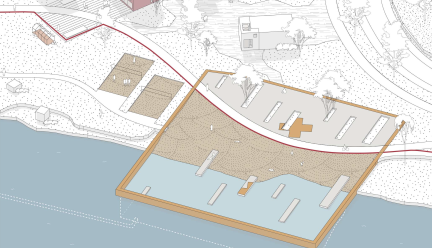
Her har eg mitt hjerte, her har eg mitt ly
We propose the Pilot project to be founded on values of ownership and community feeling, taking up…
-
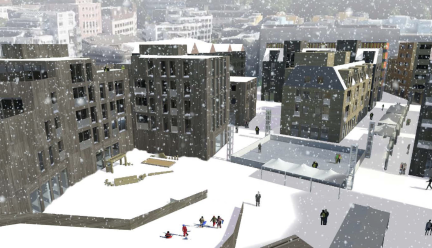
Møllendal West
What would a housing model look like if it was based on the social conscience of the co operative…
